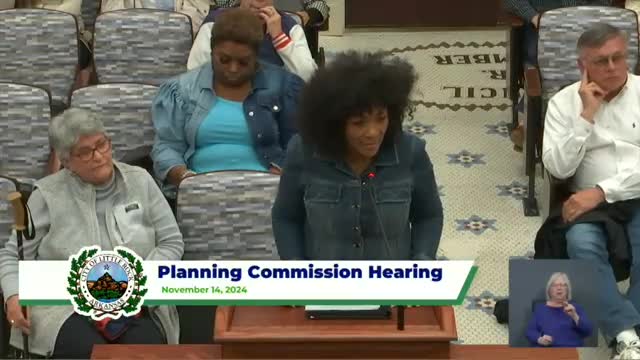Community fights to preserve historic site from redevelopment
November 15, 2024 | Little Rock City, Pulaski County, Arkansas
This article was created by AI summarizing key points discussed. AI makes mistakes, so for full details and context, please refer to the video of the full meeting. Please report any errors so we can fix them. Report an error »

In a recent government meeting, community leaders and residents voiced strong opposition to a proposed development at 1516 Ringo Street in Little Rock, Arkansas, a site of significant historical importance. The lot, once home to a structure recognized on the National Register of Historic Places, was demolished despite its cultural significance to the Dunbar Historic Neighborhood, the first African American community in the city.
Angel, the executive director of the Dunbar Historic Neighborhood Association, emphasized the lot's role as a symbol of resilience and community heritage. He argued that the proposed development, which seeks to subdivide the property into two narrow lots for single-family homes, fails to respect the historical character of the area. He highlighted the importance of preserving the lot as a historic site, stating that it represents a collective identity and a legacy that should be honored.
Trisha Bean, executive director of the Quapaw Quarter Association, echoed these sentiments, detailing the historical significance of the original home, which was associated with prominent figures in African American history, including members of the Bush family and Milton Pitts Crenshaw, a pioneering Tuskegee Airman. Bean criticized the developer's plans for their incompatibility with the architectural standards of the neighborhood, arguing that the proposed designs would disrupt the area's historic integrity and diminish its cultural value.
Mia Foreman, a local resident and owner of a neighboring historic home, expressed her frustration over the demolition of the original structure, stating that it was a loss not only for her but for the entire community. She called for new developments to reflect the historical significance of the area rather than imposing modern designs that clash with the neighborhood's character.
The developers defended their proposal, stating that the previous structure was condemned and unlivable, and that they aimed to address the housing crisis by providing new homes. They noted that they had made concessions, reducing the number of proposed lots from three to two and adjusting their designs in response to community feedback. However, their assurances did little to quell the concerns raised by residents about the potential impact on the neighborhood's historical fabric.
As discussions continue, community members remain steadfast in their commitment to preserving the cultural heritage of the Dunbar Historic Neighborhood, urging decision-makers to consider the long-term implications of development on their shared history and identity.
Angel, the executive director of the Dunbar Historic Neighborhood Association, emphasized the lot's role as a symbol of resilience and community heritage. He argued that the proposed development, which seeks to subdivide the property into two narrow lots for single-family homes, fails to respect the historical character of the area. He highlighted the importance of preserving the lot as a historic site, stating that it represents a collective identity and a legacy that should be honored.
Trisha Bean, executive director of the Quapaw Quarter Association, echoed these sentiments, detailing the historical significance of the original home, which was associated with prominent figures in African American history, including members of the Bush family and Milton Pitts Crenshaw, a pioneering Tuskegee Airman. Bean criticized the developer's plans for their incompatibility with the architectural standards of the neighborhood, arguing that the proposed designs would disrupt the area's historic integrity and diminish its cultural value.
Mia Foreman, a local resident and owner of a neighboring historic home, expressed her frustration over the demolition of the original structure, stating that it was a loss not only for her but for the entire community. She called for new developments to reflect the historical significance of the area rather than imposing modern designs that clash with the neighborhood's character.
The developers defended their proposal, stating that the previous structure was condemned and unlivable, and that they aimed to address the housing crisis by providing new homes. They noted that they had made concessions, reducing the number of proposed lots from three to two and adjusting their designs in response to community feedback. However, their assurances did little to quell the concerns raised by residents about the potential impact on the neighborhood's historical fabric.
As discussions continue, community members remain steadfast in their commitment to preserving the cultural heritage of the Dunbar Historic Neighborhood, urging decision-makers to consider the long-term implications of development on their shared history and identity.
View full meeting
This article is based on a recent meeting—watch the full video and explore the complete transcript for deeper insights into the discussion.
View full meeting
